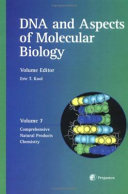
DNA and Aspects of Molecular Biology
By - Eric T. KoolThis volume is intended to cover the chemistry of one of the most widely studied and important natural products, DNA. Discussed in detail are physicochemical properties of the molecule itself as well as small-molecule natural products that are known to interact with it. Also included are methods to synthesize and manipulate DNA and modified analogues. Twenty chapters are devoted to this overall topic. thermodynamics and kinetics of double helix formation; the next two describe triple- and tetra- helical structures formed by DNA; and the last two focus on methods for probing DNA structure (specifically, NMR methods and chemical probing methods, respectively). analogues. The first of these addresses nonenzymatic methods for synthesizing DNA, and the next chapter, methods for attachment of reporter groups to it. Modifications of DNA structure are discussed in chapters eight to eleven; the first of these addresses nucleoside analogues useful as biochemical probes, while others discuss alterations to the DNA backbone, bases, and topology, respectively. The extensive chemistry of DNA damage is reviewed in the last chapter (chapter 12). Included in this group are a large number of natural and non-natural products, which fall into the classes of intercalators (chapter 13), minor groove binders (chapter 14), DNA-binding peptides (chapter 15), and DNA-damaging natural products (chapter 16). The last two chapters focus more specifically on two broad classes of medicinally important agents which interact with DNA; specifically, the enediyne natural products (chapter 17), and topoisomerase inhibitors (chapter 18). are being used in many chemically-oriented laboratories. The first (chapter 19) covers selection of novel ligands and catalysts from sequence-randomized libraries of DNA. The second (chapter 20) covers other useful molecular biology methods such as cloning and the polymerase chain reaction.